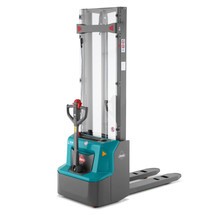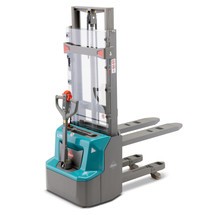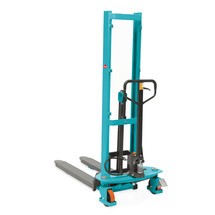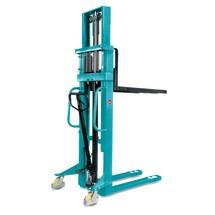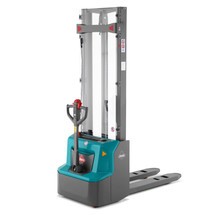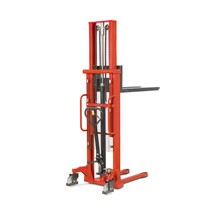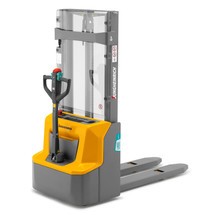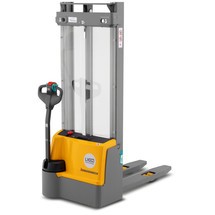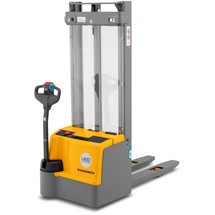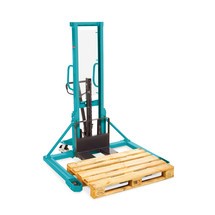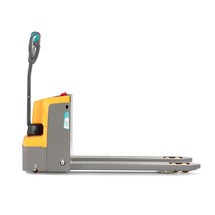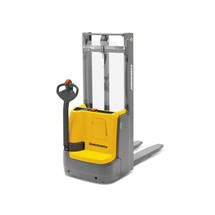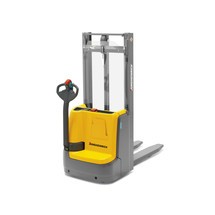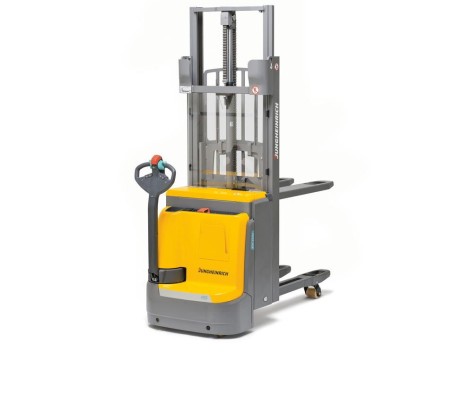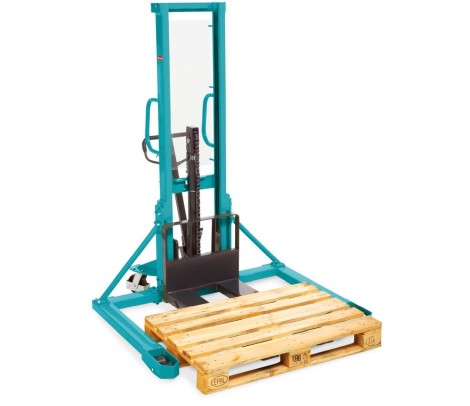Stacker trucks
Buying Tips
Filter
back
Your selection: 46 products
Ameise® PSE 1.2 electric stacker truck – lithium-ion, two-stage telescopic mast
- 4 lift heights available (2600, 2900, 3200, 3600 mm)
- Maintenance-free lithium-ion battery
- On-board charger for flexible application
Ameise® PSE 1.2 electric stacker truck – lithium-ion, two-stage telescopic mast with initial lift
- With initial lift for use on ramps
- Maintenance-free lithium-ion battery
- On-board charger for flexible application
Ameise® PSM 1.0 hydraulic stacker truck with quick lift
- Automatic quick lift (up to 100 kg)
- Single mast with 1600 mm lift height
- Small turning circle thanks to compact dimensions
Ameise® PSM 1.0/1.5 hydraulic stacker truck with single mast
- Hydraulic lifting via tiller or foot pedal
- High-performance hydraulic pump made from high-strength steel
- Overload valve for long service life
Ameise® PSM 1.0 hydraulic stacker truck with two-stage telescopic mast
- Hydraulic lifting via reinforced tiller or foot pedal
- High-performance hydraulic pump made from high-strength steel
- Overload protection for long service life
Ameise® PSE 1.2 electric stacker truck – lithium-ion, simplex mast
- 2 lift heights available (1600 and 2000 mm)
- Maintenance-free lithium-ion battery
- On-board charger for flexible application
BASIC hydraulic stacker truck with telescopic mast
- Low-maintenance and highly robust
- Loads can be raised via the tiller or foot pedal
- Rubberised tiller handle
Jungheinrich AMC 12 electric stacker truck – lithium-ion, two-stage telescopic mast
- 1200 kg load capacity
- 4 lift heights available (2600, 2900, 3200, 3600 mm)
- Maintenance-free lithium-ion battery
Jungheinrich AMC 12z electric stacker truck – lithium-ion, two-stage telescopic mast
- 1,200 kg load capacity
- Initial lift for increased ground clearance on loading ramps
- Maintenance-free lithium-ion battery
Jungheinrich EJC M10 ZT electric high-lift stacker truck – two-stage telescopic mast, lithium-ion
- 1,000 kg load capacity
- 4 different lift heights available (2,300, 2,500, 2,900 and 3,300 mm)
- Powerful, maintenance-free lithium-ion battery
Jungheinrich EJC M13 ZT electric high-lift stacker truck – two-stage telescopic mast, lithium-ion
- 1,300 kg load capacity
- 4 different lift heights available (2,300, 2,500, 2,900 and 3,300 mm)
- Powerful, maintenance-free 100 Ah lithium-ion battery
Ameise® PSM 1.0 wide-track hydraulic stacker truck
- Ideal for longitudinal and transverse lifting of Euro pallets and lifting closed-boarded U...
- Robust quality with 1000 kg capacity
- Loads can be raised via the tiller or foot pedal
Jungheinrich EJE M13 electric pallet truck – lithium-ion
- Fully electric travel, lifting and lowering function
- Powerful, maintenance-free lithium-ion battery
- On-board charger for rapid and intermediate charging
Jungheinrich EJC 112i DZ electric high-lift stacker truck with two-stage telescopic mast and free lift
- Premium quality "Made in Germany"
- 1,200 kg load capacity
- 3 different lift heights available (4,090, 4,300 and 4,700 mm)
Jungheinrich EJC 112i ZT electric high-lift stacker truck with two-stage telescopic mast
- Premium quality "Made in Germany"
- 1,200 kg load capacity
- 9 different lift heights (2,300, 2,500, 2,700, 2,900, 3,200, 3,600, 3,900, 4,100 and 4,300...
BASIC hydraulic stacker truck with single mast
- Low-maintenance and highly robust
- Loads can be lifted via the foot pedal or tiller
- Rubberised tiller handle for maximum comfort
Jungheinrich EJC 110/ZT electric high-lift stacker truck – two-stage telescopic mast
- Premium quality – "Made in Germany"
- Powerful and maintenance-free three-phase AC drive motor
- Proportional hydraulics for precision lifting and lowering
Jungheinrich EJC 112/ZT electric high-lift stacker truck – two-stage telescopic mast
- Premium quality – "Made in Germany"
- Powerful and maintenance-free three-phase AC drive motor
- Proportional hydraulics for precision lifting and lowering
